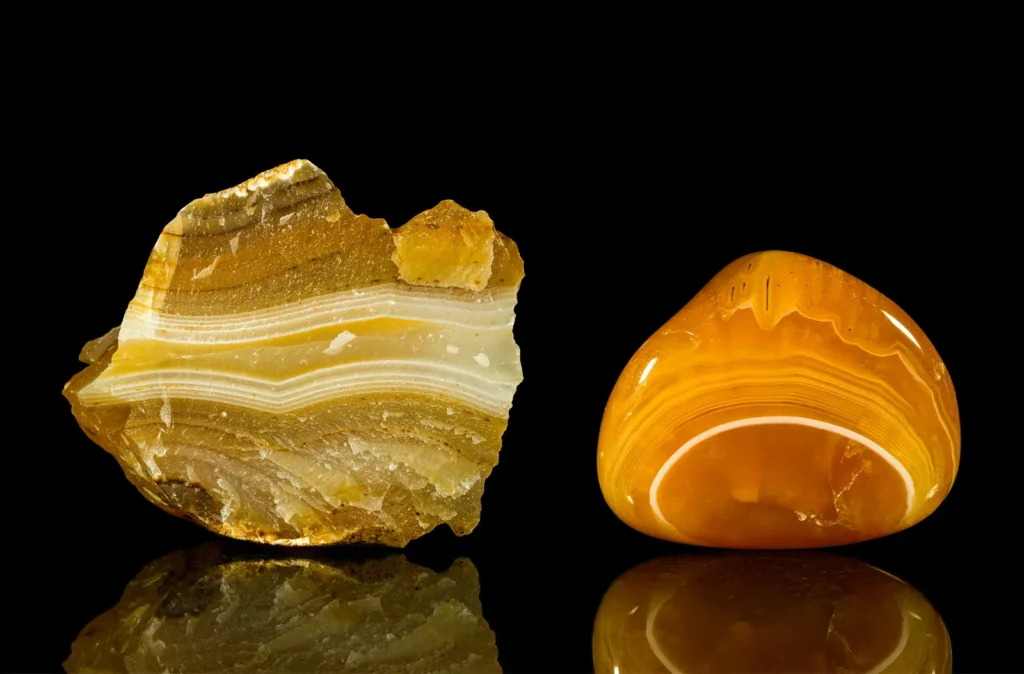
Appearance
Carnelian has a wide color spectrum; it usually ranges from pale orange to a rich reddish-brown. Additionally, it may display crimson, orange-red, and brownish-red hues. Iron oxide impurities, which can vary in concentration and distribution inside the stone, are the main cause of the pigment. Transparency of the carnelian can range from translucent to opaque. Carnelian that is translucent lets light through but is not completely transparent. On the other hand, opaque carnelian seems solid and blocks out light. Carnelian has a polished, glossy look due to its vitreous (glass-like) luster.
This distinctive luster enhances the gemstone’s allure from an aesthetic standpoint. According to the Mohs mineral hardness scale, carnelian has a hardness of 6.5-7. This indicates good durability because it ranks quite high on the scale. Even though carnelian is quite resistant, it can still be scratched or harmed by materials that are harder.
Geographical Distribution
Carnelian is present in many parts of the world. Brazil, India, Madagascar, Uruguay, and the United States are a few important sources. The geological conditions in these places are ideal for the formation and deposition of minerals rich in carnelian.
History
The mineral family that includes carnelian is quartz. When it was first used 4,500 years ago, the Sumerians and Egyptians fashioned it into body ornaments. The semi-precious gemstone was also preferred by the ancient Greeks and Romans for usage in intaglios on signet rings.
Metaphysical Properties
These days, some people believe carnelian to improve self-worth and creativity, to fight feelings of inadequacy, to boost physical energy, and to help them sleep better at night.

Chemical Composition
Chalcedony, a kind of microcrystalline quartz, is the parent stone of carnelian. Its main component is silicon dioxide (SiO2), with small amounts of iron oxide (Fe2O3) adding the distinctive reddish-orange hues.
Types
The following are some notable varieties and kinds of carnelian:
Sard:
Darker carnelian hues are referred to as “sard” specifically. It describes carnelian stones with a rich reddish-brown or brownish-red hue. In carnelian, sard is frequently linked to richness, depth, and intensity.
Botswana Agate:
One variety of banded chalcedony that occasionally has carnelian as one of its banding colors is called Botswana Agate. A variety of colors of carnelian, gray, white, and black are among the opposing bands that form its complicated and distinctive designs.
Cornelian:
An alternative term for carnelian is cornelian. While less frequently used, the term “cornelian” is practically the same as “carnelian.” The same gemstone with its characteristic reddish-orange tones is referred to by both names.
Agate-Carved Carnelian:
Carnelian is widely carved into elaborate patterns and cameos. Carnelian’s layered nature makes it an excellent material for carved gemstone objects. These sculptures frequently draw attention to the carnelian’s color variations and banding patterns.
Onyx-Carved Carnelian:
Another type of chalcedony with alternating bands of various colors is onyx. Carnelian is occasionally utilized as one of the onyx banding colors. The warm tones of carnelian and the black onyx contrast dramatically as a result of this combination.
Uses
The following are a few significant applications and uses for carnelian:
- Jewelry: Because of its inviting hues, carnelian is a popular choice for jewelry. It is frequently used to make pendants, earrings, bracelets, necklaces, and rings. Gemstones called carnelians, whether set in gold, silver, or other metals, give jewelry designs a sense of elegance and beauty.
- Decorative Objects: Decorative Items: Carnelian is a wonderful choice for decorative items because of its vibrant colors and eye-catching patterns. It has been utilized to make ornamental objects like bowls, vases, sculptures, and figures. Carnelian’s distinct color range and translucency can improve these ornamental objects’ aesthetic appeal.
- Cameos and Intaglios: Carnelian is a popular material for cameos and intaglios because of its toughness and capacity to support fine carvings. Intaglios are carved engravings that cut into the stone to form a design, whereas cameos are relief carvings that usually have a raised design on a contrasting background. The subtleties of these carvings can be brought out by deftly utilizing the diverse colors and patterns of carnelian.
- Beads and Cabochons: For usage in jewelry-making, carnelian is commonly fashioned into beads and cabochons. The colors and translucency of the gemstone are highlighted by the polished, convex surface of cabochons and the smooth, rounded shape of beads. While cabochons are frequently set in rings and pendants, carnelian beads are popular in bracelets and necklaces.
Table





